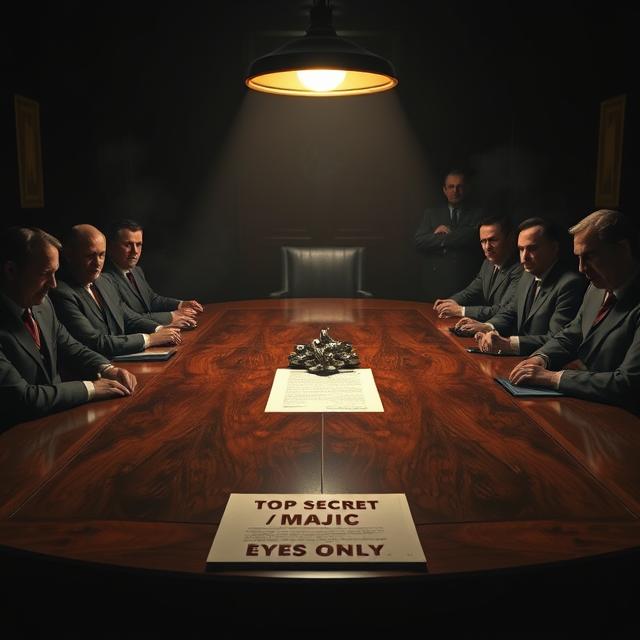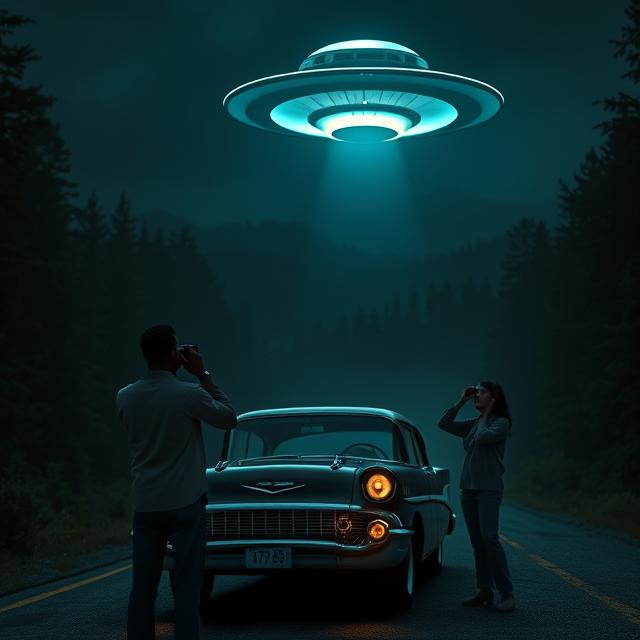In the shadowy annals of UFO conspiracy theories, few tales are as compelling, complex, and controversial as that of Majestic 12. Also known as MJ-12, this is the purported code name for a top-secret committee of elite scientists, military leaders, and high-ranking government officials. Their alleged mandate? To manage the aftermath of the 1947 Roswell crash, recover and exploit alien technology, and maintain a strict, global embargo on the most profound secret in human history: that we are not alone.
For decades, the story of Majestic 12 has been a holy grail for ufologists, representing a potential “smoking gun” that proves the U.S. government has been engaging with an extraterrestrial presence. For skeptics and the government itself, it is a textbook case of a modern hoax, a masterfully crafted piece of disinformation that has captivated and misled the public for years. The saga of the MJ-12 documents is a labyrinth of anonymous sources, mysterious leaks, and fierce debate, blurring the lines between belief, fact, and fabrication. Is Majestic 12 the hidden hand that controls alien disclosure, or is it one of the most successful hoaxes of the 20th century?
The Bombshell on a Roll of Film
The story of Majestic 12 erupted into the public consciousness in 1984. UFO researcher and television producer Jaime Shandera received a plain manila envelope in the mail with no return address and a New Mexico postmark. Inside was not a letter, but an undeveloped roll of 35mm film. When Shandera had the film developed, it revealed photographs of what appeared to be an eight-page, top-secret government document dated November 18, 1952.
Titled “TOP SECRET / EYES ONLY” and designated as a “BRIEFING DOCUMENT FOR PRESIDENT-ELECT DWIGHT D. EISENHOWER,” the document laid out a stunning narrative. It detailed the recovery of a crashed “extra-terrestrial spacecraft” and four deceased “humanoid” bodies from the desert near Roswell, New Mexico, in July 1947. To manage this unprecedented event, the document stated, President Harry S. Truman had issued an executive order on September 24, 1947, establishing a super-secret committee known as “Operation Majestic 12.”
The briefing paper listed the original 12 members of this alleged committee, a veritable who’s who of the mid-century American military, scientific, and intelligence establishment:
- Rear Adm. Roscoe H. Hillenkoetter: The first Director of Central Intelligence (CIA).
- Dr. Vannevar Bush: A renowned scientist who headed the Office of Scientific Research and Development and was a key figure in the Manhattan Project.
- James V. Forrestal: The first U.S. Secretary of Defense.
- Gen. Nathan F. Twining: A high-ranking Air Force general.
- Gen. Hoyt S. Vandenberg: The second Director of Central Intelligence and Air Force Chief of Staff.
- Dr. Detlev Bronk: A prominent biophysicist and chairman of the National Research Council.
- Dr. Jerome Hunsaker: An aeronautical engineer and head of MIT’s departments of Mechanical and Aeronautical Engineering.
- Rear Adm. Sidney W. Souers: The first Director of Central Intelligence and Executive Secretary of the National Security Council (NSC).
- Gordon Gray: Assistant Secretary of the Army and later, National Security Advisor.
- Dr. Donald Menzel: A highly respected astronomer from Harvard University.
- Maj. Gen. Robert M. Montague: A military commander.
- Dr. Lloyd V. Berkner: A physicist and expert in atmospheric science.
The existence of such a group, composed of the nation’s most powerful and trusted men, gave the story an immediate and profound sense of gravity. The document was a Rosetta Stone for the UFO phenomenon, seemingly explaining decades of government secrecy and denial.
The Search for Corroboration and the Cutler-Twining Memo
Shandera shared the documents with his colleagues, veteran UFO researchers William L. Moore and Stanton T. Friedman, a nuclear physicist who would become the most prominent and vocal defender of the MJ-12 papers. The trio understood that without corroboration, the documents, arriving out of the blue, were worthless.
In 1985, their search led them to the National Archives in Washington, D.C. Acting on a tip from another anonymous source, they discovered a memo in a box of declassified Air Force records. This document, now famously known as the “Cutler-Twining memo,” was dated July 14, 1954, and appeared to be from President Eisenhower’s Special Assistant for National Security, Robert Cutler, to Air Force Chief of Staff Nathan Twining. The memo mentioned a change of plans for a “MJ-12 Special Studies Project” briefing. This was the independent confirmation they were looking for—an official government document, found in the National Archives, that explicitly referenced “MJ-12.” The case, for many, was now blown wide open.
The Case for Authenticity: A “Cosmic Watergate”
Stanton Friedman dedicated years of his life to authenticating the Majestic 12 documents. He argued that the level of detail, the specific language, and the sheer audacity of the concept pointed to their legitimacy. His case rested on several key points:
- The Membership: The individuals listed were precisely the high-level experts in science, intelligence, and military affairs who would be chosen for such a monumental task.
- Historical Context: The creation of such a committee aligned with the post-WWII era’s explosion of secrecy, the creation of the CIA and the NSC, and the Cold War paranoia that gripped the nation.
- The Cutler-Twining Memo: Friedman saw the memo found in the National Archives as the lynchpin, arguing that a forger could not have possibly planted a fraudulent document in the government’s own files.
- Forensic Details: Friedman engaged in lengthy debates with skeptics over details like typewriter fonts and signature styles, often producing examples from the era that he argued were consistent with the MJ-12 documents.
For Friedman and other believers, the MJ-12 story represented a “Cosmic Watergate,” a massive, ongoing cover-up orchestrated by a shadow government to prevent the public from learning the truth about extraterrestrial visitation, a truth they believed would lead to societal collapse.
The Case Against: “Completely Bogus”
As quickly as the MJ-12 story electrified the UFO community, it came under intense scrutiny from skeptical investigators and, eventually, the U.S. government itself. The case against the documents is formidable and points to a deliberate and clever hoax.
In 1988, the Federal Bureau of Investigation (FBI) launched its own inquiry after receiving a copy of the documents. Their conclusion, shared publicly, was blunt and unequivocal: “The investigation was closed after it was learned that the document was completely bogus.” An agent famously scrawled “BOGUS” across the cover sheet of the case file.
The U.S. Air Force Office of Special Investigations (AFOSI) also concluded that the documents were fraudulent and that no such committee had ever been formed. The debunking efforts were led by veteran skeptical investigator Philip J. Klass, who uncovered numerous anachronisms and fatal flaws:
- The Truman Signature: The signature of President Truman on one of the key memos was found to be a “pasted-on photocopy” of a genuine signature from an unrelated, unclassified letter from Truman to Vannevar Bush dated October 1, 1947. The distinctive scratch marks on the authentic signature were perfectly replicated on the MJ-12 document, something only possible through photographic duplication.
- Robert Cutler’s Alibi: Klass discovered that Robert Cutler, the supposed author of the Cutler-Twining memo, was out of the country on official business on the day the memo was supposedly written (July 14, 1954), making it impossible for him to have written and signed it in Washington.
- Anachronistic Formatting: The date format used in the Eisenhower briefing document (e.g., “18 November, 1952”) was a strange hybrid of military and civilian styles that was not standard for classified documents of that era. Curiously, it was a format frequently used in the personal correspondence of William Moore, one of the men who received the documents.
- Wrong Terminology: The documents used terms like “media” to refer to the press, a term that did not come into common usage until the 1960s. They also referred to “extra-terrestrial” life, whereas the common term in the 1940s and 50s was “interplanetary.”
- Questionable Provenance: The very origin of the documents—anonymously mailed on a roll of film—was highly suspect. As Carl Sagan noted, it was a fantastical origin story, “like something out of a fairy story.”
An Alternative Theory: A Government Disinformation Campaign?
With the evidence for a hoax being so strong, a new and even more complex theory emerged from within the UFO community itself. What if the Majestic 12 documents were fake, but they weren’t created by a civilian prankster? What if they were an elaborate piece of disinformation, created and disseminated by U.S. intelligence agencies?
This theory gained traction when William Moore himself admitted in 1989 that he had been working with individuals connected to the AFOSI, including a special agent named Richard Doty. Doty was known for feeding disinformation to UFO researchers, most notably in the case of Paul Bennewitz, an Albuquerque businessman who was driven to a mental breakdown after being fed a stream of false information about aliens to distract him from secret Air Force projects at a nearby base.
The idea is that intelligence agents may have created the MJ-12 documents as a way to muddy the waters of UFO research, to discredit legitimate researchers by having them chase a fraudulent story, or to deflect attention from real, top-secret aerospace projects. By creating a hoax with just enough plausible detail to be enticing but with built-in flaws that would eventually be exposed, they could effectively poison the well of public discourse on UFOs.
Conclusion: A Legacy of Intrigue
In the final analysis, the evidence overwhelmingly indicates that the Majestic 12 documents are forgeries. The forensic analysis by skeptics and the official conclusions of the FBI leave little room for doubt. The story of a secret committee of twelve, born from the Roswell crash, is almost certainly a myth.
Yet, the reason for the myth’s creation remains a fascinating mystery. Was it a simple hoax by UFO enthusiasts hoping to legitimize their field? Or was it a sophisticated psychological operation run by government intelligence, a “weaponized” conspiracy theory designed to mislead and confuse?
The Majestic 12 saga stands as a cautionary tale. It highlights the immense difficulty in discerning fact from fiction in a field shrouded in secrecy and speculation. It reveals the passionate dedication of researchers on both sides of the debate and the extreme lengths to which people will go to prove their beliefs. Whether born from a desire to reveal the truth or to obscure it, the tale of Majestic 12 has left an indelible mark on UFO lore, forever representing the ultimate shadow government, the secret keepers of a truth that may or may not be out there.
Want to explore the shadows even deeper? For more chilling cases like this, visit SinisterArchive.com, where the legends are real.




